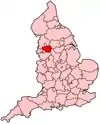Manchester Airport
Manchester Airport (IATA: MAN, ICAO: EGCC) is an international airport in Ringway, Manchester, England, 7.5 nautical miles (13.9 km; 8.6 mi) south-west of Manchester city centre.[1][3] In 2019, it was the third busiest airport in the United Kingdom in terms of passenger numbers and the busiest of those not serving London.[2][4] The airport comprises three passenger terminals and a cargo terminal. It covers an area of 560 hectares (1,400 acres) and has flights to 199 destinations, placing the airport thirteenth globally for total destinations served.[5]
Manchester Airport | |||||||||||||||
|---|---|---|---|---|---|---|---|---|---|---|---|---|---|---|---|
 | |||||||||||||||
 | |||||||||||||||
| Summary | |||||||||||||||
| Airport type | Public | ||||||||||||||
| Owner/Operator | Manchester Airport Holdings | ||||||||||||||
| Serves | Greater Manchester | ||||||||||||||
| Location | Ringway, Manchester, England | ||||||||||||||
| Opened | 25 June 1938 | ||||||||||||||
| Elevation AMSL | 257 ft / 78 m | ||||||||||||||
| Coordinates | 53°21′14″N 2°16′30″W | ||||||||||||||
| Website | manchesterairport | ||||||||||||||
| Map | |||||||||||||||
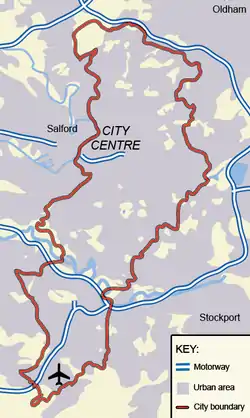 EGCC  EGCC 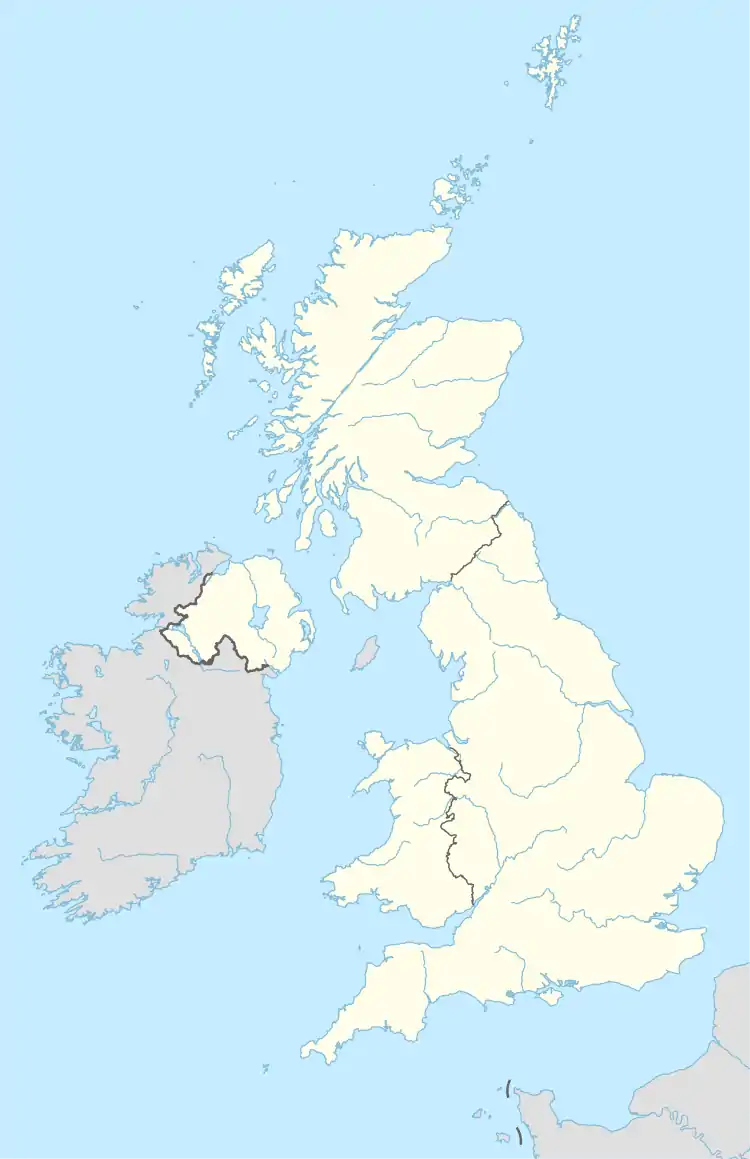 EGCC | |||||||||||||||
| Runways | |||||||||||||||
| |||||||||||||||
| Statistics (2022) | |||||||||||||||
| |||||||||||||||
Sources: MAG Manchester Airports Group website, UK AIP at NATS[1] Statistics from the UK Civil Aviation Authority[2] | |||||||||||||||
Officially opened on 25 June 1938,[6] it was initially known as Ringway Airport, a name still in local use. In World War II, as RAF Ringway, it was a base for the Royal Air Force. The airport is owned and managed by the Manchester Airport Holdings (trading as MAG), a holding company owned by the Australian finance house IFM Investors and the ten metropolitan borough councils of Greater Manchester, with Manchester City Council owning the largest stake. Ringway, after which the airport was named, is a village with a few buildings and a church at the western edge of the airport.
Future developments include the £800 million Airport City Manchester logistics, manufacturing, office and hotel space next to the airport. Ongoing and future transport improvements include the £290 million Eastern Link relief road, which opened in October 2018. A High Speed 2 station known as Manchester Airport High Speed station, once earmarked for opening in 2033, was to create a regular sub-ten-minute shuttle service for connecting rail passengers between central Manchester and the Airport while relieving stress on the Styal line to the Airport from Manchester which has become one of the most congested routes on the National Rail network.[7]
After the airport handled a record 27.8 million passengers in 2017,[2] it underwent major expansion to double the size of Terminal 2, the first elements opening in 2019.[8] The £1 billion expansion will be completed in 2024 and enable Terminal 2 to handle 35 million passengers.[9] Capacity exists for up to 50 million passengers annually with two runways;[10] however, this potential figure is limited by the airport's restriction to 61 aircraft movements per hour as well as existing terminal sizes to process arrivals and departures effectively.[11]
History
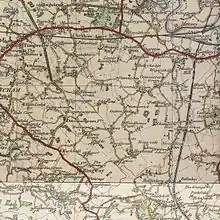
Construction commenced in Ringway parish on 28 November 1935 and the airport was partially operational by June 1937, with full construction completed on 25 June 1938.[12] Its northern border was Yewtree Lane between Firtree Farm and The Grange, east of the crossroads marked "Ringway", and its southeast border a little west of Altrincham Road, along the lane from Oversleyford running northeast then east into Styal. In 1938, KLM became the first airline to launch scheduled commercial flights to Manchester.[13]
During World War II, RAF Ringway was important in military aircraft production and training parachutists. After the War, the base reverted to a civilian airport and gradually expanded to its present size. Manchester was Britain's second-busiest airport, after Heathrow, by the 1960s.[14]
In 1946, Air France began operations from Manchester following the commencement of peacetime passenger services form the airport, and remains the airport's longest continuous operator, celebrating 75 years of service in 2021.[13] In 1953, Manchester began 24-hour operation, with the ability to handle flights during the day and night, which helped the airport handle 163,000 passengers. 1953 also saw the start of intercontinental flights by Sabena Belgian to New York, followed closely by the launch of services to New York by BOAC.[13]
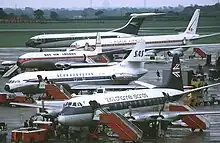
The first transatlantic flights to originate at Manchester begain in 1963. The thrice-weekly service was operated by BOAC using a Boeing 707 via Prestwick. In 1969, the runway was extended to 2,745 metres (9,006 ft), allowing aircraft to take off with a full payload and to fly non-stop to Canada.[13]
In 1971, the airport reached a milestone of handling over 2 million passengers in one year. The following year saw the opening of a link road connecting the airport to the M56 Motorway, improving road access from Manchester, Cheshire and North Wales.[13] In 1975, Ringway was officially renamed Manchester International Airport.[13]
The airport saw rapid growth and expansion during the 1980s and 1990s, shaping the airport for the coming decades. Many of the developments made during this period remain in place or have only recently been altered following the introduction of the Manchester Transformation Project. Passenger numbers continued to grow, reaching the milestone of handing one million passengers a month for the first time in 1987.[13] This growth boosted expansion plans, including planning for a new terminal. The following year, in 1988 Manchester celebrated its Golden jubilee.
Terminal A, which now forms part of Terminal 3, was opened by Diana, Princess of Wales in 1989. In 1993, Terminal 2 was officially opened by the Duke of Edinburgh along with the official opening of Manchester Airport station.[13] From 1997 to 2001, a second runway was constructed, causing large-scale protests in Cheshire, especially in the village of Styal where natural habitats were disturbed and listed buildings demolished to make space for construction.[15][16][17]
During the early 2000s, British Airways scaled down operations from Manchester Airport with the sale of their BA Connect subsidiary to Flybe and the ending of their franchise agreement with GB Airways, a business subsequently sold to easyJet. In October 2008, the daily New York–JFK service was terminated and in March 2013 the daily to London–Gatwick was ended, although the service has resumed in recent years.
Since taking over BA Connect's select routes, Flybe has gone on to add several more destinations. In 2012, Flybe introduced the "mini hub" concept co-ordinating the arrival and departure times of various domestic services throughout the day and thereby creating combinations such as Norwich–Manchester–Belfast, Glasgow–Manchester–Southampton and Edinburgh–Manchester–Exeter with conveniently short transfer times.[18]
The Airbus A380 arrived in 2010, operated by Emirates, which continues to operate the aircraft up to three times daily on its route to Dubai
Manchester Airport celebrated its 75th anniversary in 2013. That year also saw the completion and opening of the newly constructed air traffic control tower – which is now located in an independent tower, not on top of the airport as previously – and Airport City Manchester gained planning approval.[13] During 2013, Virgin Atlantic introduced its Little Red short-haul brand to take-up some of the available Heathrow and Gatwick slots, which resulted from BMI ceasing operations. Manchester was the inaugural destination, with services were operated by aircraft leased from Aer Lingus. However, these services ceased in March 2015 because of low sales.[19]
In 2014, the Manchester Airport Metrolink route launched as part of the route expansion plans of the Manchester Metrolink tramway, aiding transport to and from the airport to the city centre.[13]
In 2019, the first phase of the new Terminal 2 extension was completed, and Pier 1 opened on 1 April 2019. The second phase of the extension plan opened on 14 July 2021.
During the later part of the decade, Monarch Airlines, Thomas Cook Airlines and Flybe all entered administration and ceased operations, having a major impact on local employment and operations at Manchester, as well as leaving thousands of passengers stranded, many abroad. Monarch was an operator at Manchester between 1981 and 2017, operating short and medium flights to Europe, and had its own maintenance base at the airport.[20] It entered administration and ceased operations in 2017.[21] Thomas Cook Airlines was a major operator at Manchester, operating scheduled and charter flights to over 50 destinations in Europe, America and the Caribbean. Its parent company also had a maintenance base at the airport.[22] The airline entered compulsory liquidation in September 2019, with many aircraft left parked at the airport while payment disputes were concluded.[23] Flybe was a British airline with a significant base at Manchester, which provided more than half of UK domestic flights outside London. Plans were formulated by a consortium Including Stobart Air and Virgin Atlantic to save FlyBe with the launch of Connect Airways, but plans were dropped in early 2020 and all operations ceased.
Like most British and International airports, Manchester has been severely affected by the global COVID-19 pandemic and the subsequent reduction in air passengers. A number of airlines ceased, paused or reduced routes to the airport. The reduced passenger numbers saw the temporary closure of both Terminals 2 and 3.[24] In late 2020 American Airlines announced that its daily flights to Philadelphia would cease operation amid ongoing travel disruption caused by the Coronavirus outbreak.[25] The departure of American Airlines also marked the final US-based airline at Manchester. American Airlines had previously operated services to New York–JFK, Chicago, Dallas, Miami, Boston, and Charlotte.[26][27] Data recorded and published by the Civil Aviation Authority (CAA) show that during the first 11 months (January through November) of 2020, passenger 'Terminal & Transit' numbers dropped from 29,374,282 in 2019 to 6,787,127 in 2020.[28]
Future

As part of the Government's Future of Air Transport White Paper, Manchester Airport published its Master Plan on its proposed expansions until 2030. Demolition of older buildings, such as old storage buildings, the old Alpha Catering Building and Males Garage, to the east of Terminal 2 has already begun, to make way for a new apron and taxiway towards runway 05L/23R and an eastwards extension of Terminal 2, which is planned to provide fifteen more covered stands.
The World Logistics Hub is also part of the Airport City Enterprise Developments in south Manchester. This development is designed to meet the growing demand for cargo handling space and infrastructure outside of the southeast. Positioned on the southwest side of the A538 road, next to the southeast side of the M56 motorway across the A538 from the World Freight Terminal, it provides access to the trunk motorway network via Junction 6.
Manchester Airport has development plans to meet the growing demand to fly. One document, "The Need for Land", outlines several development ideas. Five affected areas are:
- Area A is a triangle of land between the A538 road and Runway 1 and the cargo terminal which is currently under development. It will be used together with Area E, a triangle of land west of the A538 up to the M56, with its west corner opposite Warburton Green, for the expansion of aircraft maintenance, vehicle maintenance/storage and cargo handling. The Clough Bank and Cotterill Clough areas are being enhanced with mitigation areas that will become part of the extensive Landscape Habitat Management Area. The A538 alignment to be retained and capacity has been added, as required, to meet increased traffic volumes.
- Area B is north of Ringway Road and east of Shadow Moss Road, and a car park has been provided to replace spaces lost to the Airport City development and apron/terminal expansion.
- Area C consists of several areas of land mainly inside the M56/M56 spur junction, around Hasty Lane east of M56 and around the current M56 spur. The land will be used for hotels and office space. Terminal 1's current capacity is around 11 million passengers a year,[29] compared with an annual capacity of 2.5 million passengers when it first opened.[29]
In the summer of 2009, a £50 million redevelopment programme for Terminal 1 was completed, as well as the construction of new car parking facilities and taxiways for aircraft.
- Area D consists of areas of land on both sides of Manchester Airport railway spur, at Smithy Farm and east of B5166 Styal Road around and inside railway spur junction where car parking, offices, hotels, etc. can be developed.
Passenger terminals
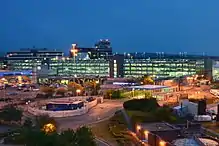
.JPG.webp)

Manchester Airport has three passenger terminals (Terminals 1, 2 and 3). Terminals 1 and 2 are linked by the skylink, with travelators (out of order since 2016) to aid passengers with the 10–15-minute walk. Terminal 3 is linked to Terminal 1 and the skylink by a covered walkway. The skylink also connects the terminals to the airport railway station complex (known as The Station) and the Radisson BLU Hotel. Skylink 1 started construction in 1991 and opened 1993. Skylink 2 opened in September 1996 along with the Radisson.
Terminal 1
Terminal 1 is used by airlines with scheduled and charter operations, flying to European and other worldwide destinations. It is the second largest terminal at the airport. It was opened in 1962, by Prince Philip, Duke of Edinburgh,[30] and it is a base for easyJet. Terminal 1 is spread over an area of 110,000 m2 (1,200,000 sq ft).
The terminal has two piers which combined have 29 stands, of which 15 have air bridges. Gate 12 was specially adapted to accommodate the Airbus A380, which is operated by Emirates on their route three times per day from Dubai to Manchester.[31] Terminal 1's current capacity is around 11 million passengers a year,[29] compared with an annual capacity of 2.5 million passengers when it first opened.[29]
In the Summer of 2009, a £50 million redevelopment programme for Terminal 1 was completed, which included a new £14 million 14-lane security area.[32] Passenger flow on Terminal 1's gating piers is due to be realigned, with plans to redesign the piers so departures and arrivals do not contraflow on the same level, allowing larger seating areas at the gates, express retail outlets and a dedicated lounge and gating area for future Airbus A380 flights. Currently only Gate 12, Pier B, has been upgraded to accommodate the A380. Part of this work saw the removal of the South Bay remote aircraft stands, constructed in 1962 between taxiways Juliet and Kilo and more recently re-aligning taxiway Juliet into an extended taxiway Bravo.
Terminal 1 is not planned to be included in the ten-year airport expansion project, and will shut in 2025 when the new Terminal 2 is completed [33] In 2025, Airlines operating from Terminal 1 will move across to the new Terminal 2, and Terminal 1 will be 'Mothballed'.
Terminal 2
Terminal 2 is used by a variety of airlines, operating both charter and scheduled flights to many European and worldwide destinations.
Terminal 2 is spread over an area of 52,000 m2 (560,000 sq ft) and has 16 gates, of which 20 have air bridges. The design of the terminal makes it capable of extensive expansion; building work has begun for an extension providing additional gates, together with the construction of a satellite pier. Terminal 2's current capacity is around 8 million passengers a year; this will be extended to ultimately handle 25 million passengers a year.[29] In 2007, an £11 million project commenced to redevelop Terminal 2 by improving security facilities and enhancing retail and catering services.
Terminal 2 received a major extension, completed in 2021, to encompass formerly remote stands to the west. Between twelve and fifteen covered aircraft stands have been made available by this. An air side link for transferring passengers between Terminals 1 and 2 is at the planning stage, designed in an effort to boost Manchester's chances of becoming a major hub airport and minimise missed connections. It was announced in June 2015 that the airport would have an expansion taking ten years to complete. Terminal 2 is now the most developed terminal, with new piers and also a larger security hall as well as more outlets.[34]
The first phase of the new extension, Pier 1, opened on 1 April 2019.[35] [36] The second phase, the terminal extension, was due to open in April 2020 but was delayed due to the impacts of the COVID-19 pandemic, finally opening on 14 July 2021.[37] The third phase, which was announced on 25 January 2023, includes the refurbishment of the existing Terminal 2 featuring a brand new security hall, and also includes the construction of Pier 2. Work is due to be complete in 2025.[33]
Terminal 3
Terminal A, as it was then known, was opened in 1989 by Diana, Princess of Wales as a self contained new domestic terminal to replace the original pier A. It had many names before its expansion and re-designation as Terminal 3 in May 1998. The terminal was known in succession as "Terminal A"; "Terminal A – Domestic"; "Terminal 1A" after Terminal 2 opened in 1993; "Terminal 1A – British Airways and Domestic"; "Terminal 3 – British Airways and Domestic" before becoming simply known as Terminal 3 in 1998. In June 1998, British Airways opened their new £75 million terminal facility designed by Grimshaw Architects, this being a major extension to Terminal A and became the primary user of the terminal along with codeshare partner airlines (Oneworld). Terminal 3 now spreads over an area of 44,400 m2 (478,000 sq ft).
PremiAir VIP terminal
Work began on the PremiAir VIP terminal (adjacent to the Runway visitor park) in 2019[38] and it opened on 21 October 2019.[39][40] Passengers are shuttled to their flight by limousine included within the service. Luggage and lounge access is an additional service offered. PremiAir is currently closed to the public "until further notice".[41]
Airlines and destinations
The following airlines operate regular scheduled and charter flights to and from Manchester:[42]
Statistics
Annual statistics
| Passengers[lower-alpha 1] | Movements[lower-alpha 2] | Freight (tonnes) | |
|---|---|---|---|
| 1990 | 10,475,641 | 121,744 | 72,255 |
| 1991 | 10,463,667 | 124,269 | 66 045 |
| 1992 | 12,051,220 | 131,010 | 74,713 |
| 1993 | 13,099,080 | 135,406 | 84,087 |
| 1994 | 14,547,477 | 142,936 | 91,055 |
| 1995 | 14,732,034 | 146,107 | 79,876 |
| 1996 | 14,642,385 | 141,070 | 78,628 |
| 1997 | 15,948,454 | 147,405 | 94,318 |
| 1998 | 17,351,162 | 162,906 | 100,099 |
| 1999 | 17,577,765 | 169,941 | 107,803 |
| 2000 | 18,568,709 | 178,468 | 116,602 |
| 2001 | 19,307,011 | 182,097 | 106,406 |
| 2002 | 18,809,185 | 177,545 | 113,279 |
| 2003 | 19,699,256 | 191,518 | 122,639 |
| 2004 | 21,249,841 | 208,493 | 149,181 |
| Source: United Kingdom Civil Aviation Authority[78] | |||
| Passengers[lower-alpha 1] | Movements[lower-alpha 2] | Freight (tonnes) | |
|---|---|---|---|
| 2005 | 22,402,856 | 217,987 | 147,484 |
| 2006 | 22,422,855 | 229,729 | 148,957 |
| 2007 | 22,112,625 | 222,703 | 165,366 |
| 2008 | 21,219,195 | 204,610 | 141,781 |
| 2009 | 18,724,889 | 172,515 | 102,543 |
| 2010 | 17,759,015 | 147,032 | 115,922 |
| 2011 | 18,892,756 | 158,025 | 107,415 |
| 2012 | 19,736,502 | 160,473 | 96,822 |
| 2013 | 20,751,581 | 161,306 | 96,373 |
| 2014 | 21,989,682 | 162,919 | 93,466 |
| 2015 | 23,136,047 | 164,710 | 100,021 |
| 2016 | 25,637,054 | 183,731 | 109,630 |
| 2017 | 27,791,274 | 203,631 | 123,576 |
| 2018 | 28,275,972 | 201,239 | 117,264 |
| 2019 | 29,397,357 | 202,892 | 108,382 |
| Source: United Kingdom Civil Aviation Authority[78] | |||
| Passengers[lower-alpha 1] | Movements[lower-alpha 2] | Freight (tonnes) | |
|---|---|---|---|
| 2020 | 7,034,856 | 66,760 | 48,938 |
| 2021 | 6,085,103 | 60,376 | 52,564 |
| 2022 | 23,364,471 | 151,724 | 65,403 |
| Source: United Kingdom Civil Aviation Authority[78] | |||
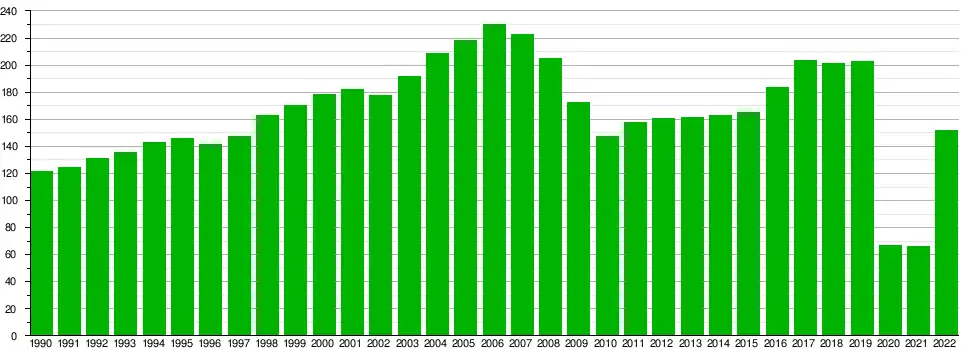 |
| Updated: 8 August 2020[78] |
Busiest routes
| Rank | Airport | Total passengers | Change 2018 / 19 | Airline(s) |
|---|---|---|---|---|
| 1 | Tenerife–South | 814,495 | easyJet, Jet2.com, Ryanair, TUI Airways | |
| 2 | Dublin | 810,494 | Aer Lingus, Ryanair | |
| 3 | Dubai–International | 765,235 | Emirates | |
| 4 | Alicante | 716,459 | easyJet, Jet2.com, Ryanair, TUI Airways | |
| 5 | Palma de Mallorca | 705,082 | easyJet, Jet2.com, Ryanair, TUI Airways | |
| 6 | Amsterdam | 704,217 | easyJet, KLM | |
| 7 | Antalya | 581,136 | Corendon Airlines, easyJet, Freebird Airlines, Jet2.com, Pegasus Airlines, SunExpress, TUI Airways | |
| 8 | Doha | 573,229 | Qatar Airways | |
| 9 | Málaga | 524,725 | easyJet, Jet2.com, Ryanair, TUI Airways | |
| 10 | Paris–Charles de Gaulle | 515,019 | Air France, easyJet |
Operations
Maintenance bases
Manchester Airport is the home to the engineering base of Jet2.com and, up until 23 September 2019, it was also the engineering base of the Thomas Cook Group Airlines. Airlines such as Etihad Airways also have one of six maintenance bases worldwide in Manchester with their newly opened (2011) line maintenance facility.[80]
World Freight Terminal
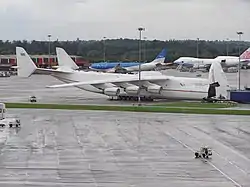
Manchester Airport has a World Freight Terminal, serving cargo-only freighter services and cargo carried on regular passenger flights.[81] It was opened in 1986, west of the original airfield. There are 5,500,000 sq ft (510,000 m2) of warehouse and office space on site, including a chiller unit for frozen products and a border inspection post. There are three aircraft maintenance hangars, with five transit sheds, operated by British Airways World Cargo, Swissport Cargo, Menzies World Cargo, and dnata UK. There are over 100 freight forwarding companies on site.[81]
Freight throughput at the airport grew from 94,000 tonnes in 1997 to the peak at 165,000 tonnes in 2007, but then declined to around 93,000 tonnes in 2013, subsequently increasing to over 109,000 tonnes in 2016 making Manchester the fourth-busiest UK airport for freight behind London–Heathrow, East Midlands and London–Stansted airports.[2]
Runways
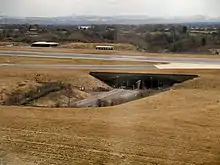


Manchester Airport has two parallel runways. Runway 1 (23R/05L) 3,048 m × 45 m (10,000 ft × 148 ft) and Runway 2 (23L/05R) 3,200 m × 45 m (10,499 ft × 148 ft).[1] The parallel runways lie 390 m (1,280 ft) apart and staggered by 1,850 m (6,070 ft) so that landings can be conducted independently on one runway whilst takeoffs are conducted on the other.[82]
The original main runway, then designated 06/24 and initially 3,300 ft (1,006 m) in length,[83] opened on 17 May 1937[84] when the airport was used as an RAF base and a military aircraft assembly centre. It was extended in stages from 1952, reaching its current length in 1981 to attract long-haul international traffic. As demand and aircraft movements both increased during the mid-1990s, mainly due to the newly completed Terminal 2, the airport studied the option of a second full-length runway. A consultation process began and planning permission was approved in 1997, with construction work starting the same year.
The second runway, initially designated 06R/24L,[85] became operational on 5 February 2001[84] at a cost of £172 million,[85] and was the first full-length commercial runway to open in Britain for over 20 years.[85] The site where the second runway was constructed was on the southern airfield boundary, which is near the village of Styal in the Cheshire countryside. The project was deemed controversial because of the destruction of natural wildlife habitats[86] and because of changes to flight paths to enable aircraft to fly in and out of the second runway. Aircraft landing from the southwest on to Runway 2 (05R) fly lower over the residential area of Knutsford.[87] As aircraft rarely land on to Runway 2 from the northeast (Runway 23L) or takeoff from Runway 2 to the northeast (Runway 05R) there has been no change to the path of aircraft over Heald Green, Cheadle and Stockport.
Planning permission for Runway 2 (23L/05R) permits use of both runways between the hours of 06:00–22:00.[84] At night between the hours of 22:00–06:00 single runway operations based on Runway 1 (23R/05L) are used.[84] Exceptions are made for emergencies and planned maintenance. In practice, dual runway operations incorporating Runway 2 (23L/05R) are only used at peak demand, which is currently in the morning and then again between 13:00–20:00.[88]
Most aircraft arriving into Manchester Airport use the instrument landing system, which in line with most other airports has a glide slope of 3 degrees equal to descending 318 feet (97 m) per nautical mile.[84] The prevailing wind direction is westerly, so normally aircraft fly from northeast to southwest. In practice this means that normally aircraft land from the northeast over Stockport, Cheadle, and Heald Green, and takeoff towards Knutsford. In dual runway operations aircraft will usually land on to Runway 1 (23R) and depart from Runway 2 (23L). When the wind direction changes, usually affecting 20% of movements per annum,[84] operations are reversed with aircraft landing from the southwest, lining up to the south over Northwich and over Knutsford and taking off towards Stockport.[84] In dual runway operations aircraft will usually land on to Runway 2 (05R) and depart from Runway 1 (05L).[84] Sometimes, aircraft arriving into Manchester Airport are held in stacks, usually in poor weather when the movement rate decreases.[84] The airport has three stacks: DAYNE, MIRSI and ROSUN, each located approximately 15/20 miles from the airport.[84] DAYNE serves arrivals from the south, ROSUN from the north and east and MIRSI from the west.[84] Residents living within 20 miles (32 km) of the airport will likely see and hear aircraft.[84]
Control tower
A new control tower was opened on 25 June 2013. At 60 m tall, it is the UK's second tallest control tower, after London Heathrow and it replaces the old tower on top of Terminal 1.[89]
Security
Manchester Airport is policed by the Greater Manchester Police and Manchester Airport Fire Service. Several security-related incidents have occurred at the airport in recent years.
- In 2002, a security firm successfully smuggled fake explosives, detonators and genuine firearms onto a flight.[90]
- In 2004, the BBC's Whistleblower programme revealed security failures at the airport, including faulty metal detectors and a lack of regular random baggage checks.[91] Many of the claims made on the programme were later discredited and much of the camera work was found to be misleading (filming from a raised footpath was used to suggest there was no security fence on the southern perimeter of the site).
- In 2005, police used a taser on a man spotted acting suspiciously on the apron, after he appeared to resist arrest.[92]
- On 6 June 2006, Aabid Hussain Khan, 21, of West Yorkshire and a 16-year-old boy were arrested at the airport and later charged under Section 57 of the Terrorism Act, for conspiracy to murder and conspiracy to cause public nuisance by using poisons or explosives.[93]
- On 24 July 2012, an 11-year-old boy went straight through security and managed to board the nearest boarding flight from security in T1, which was a Jet2 flight to Rome. Halfway through the flight one passenger reported him to the cabin crew, who then detained the boy at Rome and put him on the next flight back to Manchester.[94]
- On 5 August 2014, a 47-year-old man was arrested after the pilot of a plane became aware of a potential explosive device on board. This turned out to be a hoax. As a result, Manchester Airport airfield operations were suspended for around 30 minutes whilst the man was led away by armed police. The incident required an escort from an RAF Typhoon jet into Manchester.[95]
- In April 2015, the passengers arriving from Madrid on a Ryanair flight entered the UK without having their passports checked. A spokesman for the airport said it was the responsibility of the airline's handling agent to notify the UK Border Force about flights from outside the UK.[96]
- In November 2017, the passengers arriving on an EasyJet flight from Paris were mistakenly directed to departures rather than arrivals. The situation was caused by a door that was opened by a staff member, which led to the cross-contamination of arriving and departing passengers. The security breach resulted in confusion and delays, with a spokesman for the Department of Transport stating that it is the responsibility of airlines and airport operators to ensure passengers arriving in the UK are directed through the correct route.[97]
Ground transport
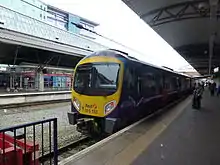

Rail
Manchester Airport station, opened in May 1993,[98] is between Terminals 1 and 2. It is linked to the terminals by a Skylink moving walkway. Trains operated by Northern, TransPennine Express and Transport for Wales connect the airport to Manchester Piccadilly and other railway stations, mainly throughout northern England, including Crewe, Wigan, Blackpool North railway station, as well as Edinburgh and Glasgow in Scotland and Holyhead and Llandudno in Wales. A third platform was completed in 2008 to allow for an increase in rail capacity. In 2009, Network Rail stated that the third platform meant that capacity will become constrained by the layover of the trains and recommended building a line underneath the Airport towards Northwich by 2024.[99] In January 2013, the Government announced that a new railway station, Manchester Airport High Speed station on the north side of the M56 will be included in Phase 2 of High Speed 2 which will provide links with other British cities like Birmingham and London and also a quicker route into Central Manchester. Work on building a new fourth platform at the existing railway station commenced in early 2014 with a blockade required in February 2015 to allow completion.[100] Construction finished in May 2015 and the platform opened to passengers in autumn 2015.[101]
Metrolink

A Metrolink service from Cornbrook station to the Airport opened in November 2014 and runs at 12-minute frequency. Journeys along the 15-stop line from Cornbrook take approximately 35 minutes. The Manchester Metrolink light rail system has had plans to extend to the airport for many years. When the idea of a congestion charge was mooted, part of the scheme was to have extended the Metrolink to the airport. However, when this was rejected, the future of the scheme was in doubt. In 2009, it was announced that the line to the airport would finally be built. The airport line is one spur of the line from St Werburgh's Road to East Didsbury and Manchester Airport, which opened on 3 November 2014 – 18 months ahead of schedule.[102][103] As of November 2022, Metrolink services from the Airport operate to Manchester Victoria via Market Street.
Bus and coach
The Station is the airport's ground transport interchange and brings bus, coach and rail passengers under one roof. Over 300 trains, 100 coaches and 500 buses a day use the facility,[104] including the 24-hour bus service 43,[105] which runs every 10 minutes (every 30 minutes at night) to Manchester city centre via Wythenshawe, Northenden, Withington, Fallowfield and Rusholme. There is also Skyline service 199 operating every 30 minutes to Buxton via Stockport, Disley and Chapel-en-le-Frith, as well as a number of Stagecoach Manchester and Arriva North West services to Stockport, Altrincham and various parts of South Manchester. A network of National Express and Megabus coach services serve Manchester Airport and operate to destinations further afield.[106]
Road
The airport is a 20-minute drive from Manchester city centre and is reached by the M56 motorway, with a dedicated approach road from the motorway at junction 5. The M56 is the main route used by traffic to reach the airport. There are also minor local roads serving the airport from the north (Wythenshawe) and the east (Heald Green). The M56/A538 road junction serves the World Freight Terminal, to the west of the airport. The A538 runs east–west serving the local towns of Altrincham and Wilmslow.
Proposed as part of the SEMMMS (South East Manchester Multi-Modal Strategy) Relief Road Scheme, a new link road to the A6 south of Stockport opened in 2018. Planning permission had been granted, with inquiries for Compulsory Purchase and Side Roads Orders following up in September 2014.[107] After significant delays, the link road opened on 15 October 2018.[108]
Taxi ranks are situated by arrivals at all three terminals.
Parking
The airport's official short-stay car parking can be found in the multistorey car parks adjacent to Terminals 1, 2 and 3. In July 2007, the airport introduced a 'No Waiting' restriction on all access roads surrounding the terminals. As of June 2018, the public are required to pay charges of £3 for five minutes on the terminal forecourt or £4 for the maximum ten minutes in order to drop off passengers. The charges have been highly controversial: local taxi drivers have described them as a "cash cow" for the airport,[109] and were described by a judge for Minshull Street Crown Court as "extraordinary" and "an absolute disgrace" after he gave a psychology teacher a suspended sentence for deliberately driving into a parking official in an act of road rage over the charges.[110]
In 2009/2010, Terminal 1's multi-storey car park was refurbished. Each level of the car park is colour-coded. The floor, walls, ceiling and supports have all received a repaint with every parking space having a sensor and green light above it, with empty parking bays indicated by the green light.
Official long-stay on-airport parking from Manchester Airport is located near the terminals and served by a regular courtesy bus. There is one long-stay car park serving Terminals 1 and 3 and a separate dedicated long-stay car park for Terminal 2. In 2009, the airport opened JetParks – two long-stay car parks less than a mile from the terminals. This is a cheaper alternative to the on-site car parks and is served by a 24-hour shuttle bus every 15 minutes. The airport also operates a Shuttle Park for long-stay car parking, which is also served by a regular courtesy bus and is located just off the airport site to the east of Terminal 3. The airport has since augmented these products with a 3rd JetParks car park, JetParks 3. This is located adjacent to Shuttle Parks and, as a result, Shuttle Parks was renamed JetParks Plus. Manchester Airport also operates a very large scale valet parking product across all 3 terminals that it has branded as "Meet & Greet".[111]
In 2014, a new 9,000 space car park located underneath the approach to 23R was constructed, the first area of the site opened in the autumn. The remainder of the facility will open in time for summer 2015.
There are several privately operated car parks within a short distance of the airport, served by shuttle bus, as well as several off-site companies operating valet parking services.
Drop off zones
Up until 2018, cars dropping off passengers could do so outside terminals for free. On 10 July 2018, Manchester Airport took the step of introducing a fee of £3 to £4 for vehicles dropping off passengers at terminals.[112] Alternatively, passengers being dropped off can be taken to an off-site car park from where a shuttle bus operates to the terminals. The airport issues fines of up to £100 to vehicles which breach its terms and conditions for the drop off zones.[113] The changes have been seen as unwelcome and nonconstructive by passengers and taxi drivers, with some saying they will boycott the airport.[114] The change has also attracted criticism from local Councillors in Cheshire, who point out that many places directly under Manchester Airport's flight paths do not have a direct public transport link to the airport. While some other UK airports also have drop off charges, Manchester Airport's charges are overall higher than those at any other airport.[115]
Effect on the area
Between 1997 and 1999 three protest camps were set up to oppose the building of the second runway, the felling of nearby trees on land owned by the National Trust in Styal, Cheshire and air transportation in general. Camps were set up in Flywood, Arthur's Wood[116] and Cedar's Wood. Swampy, a well known activist, was among many protesters.[117]
The south west end of the new runway is closer to the town of Knutsford and to the village of Mobberley. There was initially an increase in noise experienced by local residents from the aircraft being lower and closer.[87] All residents that were able to prove that their property had lost value, as a result of the operation of Runway 2, were compensated in 2010.[118] In 2012 Manchester Airports Group made a further, voluntary payment, to compensate those who felt aggrieved but had been unable to prove financial harm as a result of the operation of Runway 2. The precepts for Knutsford Town Council and Mobberley Parish Council residents were paid and money invested in local schools.[119]
In 2007 Manchester Airport applied to build on land in Styal to increase its car parking. However, the former Macclesfield Borough Council refused to give them planning permission to do so and expressed annoyance at the airport for not investing enough in public transport.[120]
Accidents and incidents
- On 27 March 1951, a Douglas C-47A-75-DL Dakota 3 cargo aircraft operated by Air Transport Charter[121] and en route to Nutts Corner, Antrim, Northern Ireland, crashed at Heyhead shortly after take-off from runway 06, following the aircraft's failure to gain height. There were four fatalities – two of the three crew on board and two of the three passengers. The subsequent investigation found that the crash resulted from a loss of engine power, caused by ice forming in the carburettor intakes, attributable to the captain's failure to use the heat controls. An extended undercarriage and snow on the wings may have also been contributory factors.[122]
- On 14 March 1957, British European Airways Flight 411 operated by Vickers Viscount 701 (registration G-ALWE) inbound from Amsterdam crashed into houses in Shadow Moss Road, Woodhouse Park. The aircraft was on final approach to Runway 24 at Manchester Airport and the crash was due to a flap failure, caused by fatigue of a wing bolt. All 20 occupants on board died, as did two on the ground.
- On 4 June 1967, a British Midland International Canadair C-4 Argonaut (registration G-ALHG) was inbound from Palma and crashed near the centre of Stockport after loss of engine power due to fuel problems and an aborted approach to Manchester Airport, with 72 fatalities.
- On 20 March 1969, Vickers Viscount G-AVJA of British Midland International crashed on take-off. Three of the four people on board were killed.[123]
- On 22 August 1985, an engine of a Boeing 737–236 Advanced, operated by British Airtours, failed during take-off from runway 24, the fire spreading into the cabin, resulting in 55 fatalities (mostly from smoke inhalation) aboard the Boeing 737–236 Advanced G-BGJL. The uncontained engine failure was later traced to an incorrectly repaired combustor causing the turbine disc to shatter and puncture the wing fuel tanks.[124][125] As a result, fire resistance and evacuation procedures were improved.[126]
Runway Visitor Park


Manchester Airport has had public viewing areas since the airport opened to the public in 1938. The 1960/1970s pier-top viewing facilities have been closed because of security concerns. In May 1992, an official "Aviation Viewing Park" (AVP) was created just off the A538 road on the south-western side of the airfield. This was moved to the western side of the airfield in May 1997 to allow construction of the second runway.[127] Renamed the "Runway Visitor Park" in June 2010, the facility is regarded as providing the best official viewing facilities for aircraft spotting at any major UK airport by aircraft enthusiasts.[128] Visitors can view aircraft taking off and landing from both runways and aircraft taxiing to and from the runways. This attraction now draws around 300,000 visitors a year and is one of Greater Manchester's top 10 attractions.[129]
The Runway Visitor Park is also home to a small number of retired aircraft exhibits. These currently are:
• Avro RJX100 Prototype (Registration: G-IRJX). This was the last British-built jetliner. It was delivered in 2001 from the nearby, but now-demolished Woodford Aerodrome. It was the first exhibit to be added to the park.[130]
• British Airways Concorde (Registration: G-BOAC 'Alpha Charlie'). Was acquired shortly after the retirement of the British Airways Concorde fleet in 2003. It has since been enclosed in a purpose-built hangar with a conference centre hosting regular events. This particular aircraft was the flagship of the British Airways fleet due to its G-BOAC designation, a reference to BOAC – a forerunner airline to British Airways.[131]
• Front Fuselage of Monarch Airlines DC-10-30 (Registration: G-DMCA). This was the only DC-10 operated by now-defunct Monarch Airlines, operating between 1996–2001. The original complete airframe was held at Manchester for a short while after being retired and subsequently scrapped, the front section being moved to the park in 2003. It is the only remains of a DC-10 in the UK.[132]
• BEA Trident 3 (Registration: G-AWZK). This aircraft last flew in 1985 and had been used for tug and de-ice training at Heathrow Airport. It was moved to the park in 2004, and opened to visitors in 2007. It is both the oldest and longest retired of all the exhibits.[133]
• RAF Nimrod MR2 (Registration: XV231). First deployed in the 1970s and retired in the late 2000s. This aircraft was used in specialist search and rescue missions. It had been used In The Falklands War as well as in Iraq and Afghanistan. It was flown into Manchester and out in display in 2010. It is the only military exhibit.[131]
Notes
- The number of domestic and international passengers
- The number of total air transport takeoffs and landings
References
- "Manchester – EGCC". Nats-uk.ead-it.com. Archived from the original on 1 February 2010. Retrieved 4 April 2010.
- "Aircraft and passenger traffic data from UK airports". UK Civil Aviation Authority. 11 March 2017. Retrieved 11 March 2017.
- "Live Search Maps". Microsoft.
- "Manchester Airport is 'ready' for A380 Super Jumbo". BBC News. 19 August 2010. Retrieved 1 September 2010.
- "Frankfurt with almost 300 destinations and Paris CDG with over 100 airlines lead global analysis of airport operations in S17". anna aero. 15 February 2017. Retrieved 12 March 2017.
- Scholefield 1998, p. 10
- "Timetable recast: too much, too quickly". Railway Gazette. 4 June 2018. Retrieved 13 August 2018.
- "Two years on Site | Manchester Airport Transformation Programme". Manchester Airport. 30 August 2019. Archived from the original on 1 November 2019. Retrieved 1 November 2019.
- "One Year on Site". Manchester Airport. 17 August 2018. Archived from the original on 27 August 2018. Retrieved 27 August 2018.
- "Transport Committee Written evidence from Manchester Airports Group (AS 44)". Parliament of the United Kingdom. 19 October 2012. Retrieved 16 August 2013.
- "Manchester Airport – The Need for Land". 19 March 2015. Archived from the original on 19 March 2015.
- "Manchester Airport – Our History". manchesterairport.co.uk. 27 November 2020.
- "History of MAN". History of MAN. Retrieved 21 January 2021.
- "Southend Airport's revival gets under way". The Telegraph. 30 March 2012. Archived from the original on 12 January 2022. Retrieved 5 April 2012.
It is hoped this will be the beginning of a comeback for the airport, which, during the 1960s, was Britain's third-busiest, behind Heathrow and Manchester
- McKeegan, Alice (18 February 2011). "Video and pictures: Manchester Airport's runway protestors reunited 14 years on". Manchester Evening News. Retrieved 21 September 2018.
- "Manchester's second runway ready for take-off". Telegraph.co.uk. 12 December 2000. Archived from the original on 12 January 2022. Retrieved 21 September 2018.
- "AirportWatch – History of the Manchester Airport second runway battle". Airportwatch.org.uk. Retrieved 21 September 2018.
- "Corporate Media News archive". Flybe. 8 March 2012. Archived from the original on 1 July 2012. Retrieved 1 February 2013.
- "Little Red". Virgin Atlantic. Retrieved 23 January 2016.
- "Hundreds of jobs lost as former Monarch maintenance arm collapses". The Drum. 4 January 2019. Retrieved 3 February 2020.
- "Monarch Airlines enters administration as brand buckles under pressure". The Drum. 2 October 2017. Retrieved 3 February 2020.
- "Fascinating pictures show inside the aircraft hangar at Manchester Airport where engineers fix planes". Manchester Evening News. 12 November 2016. Retrieved 3 February 2020.
- "Thomas Cook enters compulsory liquidation as 11th-hour rescue talks fail". The Drum. 23 September 2019. Retrieved 3 February 2020.
- "Manchester airport to close terminal 3 again". Business Traveler.
- "American Airlines withdraws service to Manchester Airport". Marketing Stockport. 23 December 2020. Retrieved 21 January 2021.
- "US Airways – Route map". Retrieved 2 June 2015.
- "US Airways draft summer schedule to Europe out – The Meck Deck". Archived from the original on 12 September 2015. Retrieved 2 June 2015.
- "Airport data 2020 01 | UK Civil Aviation Authority". www.caa.co.uk. Retrieved 22 January 2021.
- "masterplan – jan – new" (PDF). Archived from the original (PDF) on 27 March 2009. Retrieved 4 April 2010.
- Craig, Jeananne (2 July 2009). "Manchester airport terminal relaunched after £50m facelift". The Independent. Retrieved 3 April 2016.
- "List of A380 Gates". Archived from the original on 29 November 2014. Retrieved 2 June 2015.
{{cite web}}: CS1 maint: bot: original URL status unknown (link) - "Manchester Airport £50m overhaul complete". UK Airport News. Archived from the original on 21 July 2011. Retrieved 4 July 2009.
- "MAG announces £440m final phase of Transformation Programme". MAG announces £440m final phase of Transformation Programme. Retrieved 25 January 2023.
- Ansari, Arif. "Manchester Airport: £1bn plan to 'transform' site launched". BBC News. Manchester: BBC English Regions. Retrieved 2 June 2015.
- @manairport (3 April 2018). "This week marks one year until the opening of the first pier as part of our Transformation Program!✈️" (Tweet). Retrieved 21 September 2018 – via Twitter.
- "One-to-one with Robert Smith, Head of Aviation Development, Manchester Airport". anna.aero. 20 February 2019.
- Britton, Paul (19 March 2019). "The first look inside Manchester Airport's Terminal 2 expansion – new images". men.
- "PremiAir VIP Terminal". Civils & Groundworks. 25 March 2019.
- "Official Manchester Airport PremiAir | PremiAir Lounges". premiair.manchesterairport.co.uk.
- "PremiAir | Manchester Airport's Private Terminal". Manchester Airport. Retrieved 21 November 2019.
- "Premiair: Manchester Airport's Private Terminal". Manchester Airport.
- manchesterairport.co.uk – Flight Timetables Archived 8 November 2016 at the Wayback Machine. Retrieved 7 November 2016.
- https://www.corendonairlines.com/
- "EasyJet to to[sic] ramp up activity further at Belfast City Airport". 20 March 2023.
- "News for Airlines, Airports and the Aviation Industry | CAPA".
- Orban, André (13 July 2023). "easyJet to start direct flights from London Gatwick and Manchester to Kittilä Airport in November".
- "EasyJet to start serving Skiathos next summer".
- centreforaviation.com - EgyptAir to commence Cairo-Manchester service in Jul-2023 3 May 2023.
- "ETHIOPIAN AIRLINES NW22 EUROPE NETWORK CHANGES: NEW ZURICH SERVICE". Aeroroutes. 20 July 2022. Retrieved 20 July 2022.
- "Hainan Airlines Resumes Manchester Service in Aug/Sep 2022". Aeroroutes. Retrieved 19 August 2022.
- https://travelweekly.co.uk/news/air/jet2-introduces-morocco-flights-and-holidays
- https://travelweekly.co.uk/news/air/jet2-introduces-morocco-flights-and-holidays
- "jet2 announces new route to Bergen commencing May 2024". 9 December 2022. Retrieved 10 December 2022.
- Weekly, Travel. "Jet2 expands summer 2020 network to Greece". Travel Weekly.
- "Jet2.com and Jet2holidays launch two new Italian destinations for Summer 22 – Sicily and Sardinia". Jet2.com. 1 April 2021. Archived from the original on 9 July 2021.
- "Santorini added to our growing collection of Greek destinations". Jet2.com. 3 December 2019. Archived from the original on 3 December 2019.
- Weekly, Travel. "Jet2 adds extra summer 2022 routes from four bases". Travel Weekly.
- Casey, David. "Manchester, Madrid and Moscow Among Kuwait Airways' Network Additions". Routesonline. Retrieved 1 February 2022.
- "Luxair Resumes Manchester Service from April 2024". AeroRoutes. 31 August 2023. Retrieved 1 September 2023.
- "Pegasus'tan Antalya, Dalaman ve İzmir için büyük planlama". 18 March 2021. Archived from the original on 16 September 2021. Retrieved 24 March 2021.
- "Ryanair sbarca in Albania. Attacco frontale a Wizz Air". 8 June 2023.
- "Ryanair tnie jedną piątą lotów z Modlina. "Ogromna strata"". 8 September 2023.
- "Ryanair NW23 Network Changes – 17SEP23".
- "Ryanair". Ryanair.
- "Ryanair Manchester - Podgorica". Ryanair.
- "Ryanair tnie jedną piątą lotów z Modlina. "Ogromna strata"". 8 September 2023.
- "SAS to resume Manchester-Bergen flights".
- "Singapore Airlines to relaunch Manchester-Houston connections".
- Finlay, Mark (8 June 2021). "Singapore Airlines Looks To Restart A350 Flights To Manchester". Simple Flying. Retrieved 10 June 2021.
- https://southwindairlines.com/en
- "Flight Timetable". tui.co.uk.
- "Tui River Cruises unveils summer 2024 programme".
- "TUI Airways NW23 Frankfurt Charters". AeroRoutes. Retrieved 11 April 2023.
- "TUI FILES UK – GOA MANOHAR SCHEDULE IN NW23". Aeroroutes. 18 May 2023. Retrieved 22 May 2023.
- "TUI links with Manchester for UK's only direct flights to Egyptian resort of Luxor | TheBusinessDesk.com". 20 July 2023.
- "TUI Airways Adds Singapore Charters in NW23". AeroRoutes. 10 April 2023.
- "Direct flights from Manchester to the US West Coast return as Virgin Atlantic announces Las Vegas route". Manchester Airport Media Centre. 1 June 2023.
- "Aircraft and passenger traffic data for UK airports". UK Civil Aviation Authority. 2020. Retrieved 9 February 2020.
- "Airport data 2019". Tables 12.1(XLS) and 12.2 (XLS). Retrieved 25 March 2022.
- "Etihad marks two more Manchester milestones". Etihad Airways. 1 October 2011. Archived from the original on 22 January 2013. Retrieved 11 March 2012.
- "Cargo and the World Freight Terminal". Manchester Airport. Retrieved 10 October 2019.
- "Manchester vMATS Part 2 – Revision 3". 3 March 2016. Archived from the original on 3 March 2016.
- Scholefield 1998, p. 17
- "Archived copy" (PDF). Archived from the original (PDF) on 18 May 2012. Retrieved 21 April 2014.
{{cite web}}: CS1 maint: archived copy as title (link) - "Fact Sheet: Airport Summary". Manchester Airport. Archived from the original on 11 March 2012. Retrieved 4 April 2010.
- "Flight path to destruction" (PDF). Archived from the original (PDF) on 23 June 2006.
- "Knutsford Guardian – Residents wait for airport to pay out". Archive.knutsfordguardian.co.uk. 19 December 2007. Archived from the original on 2 March 2009. Retrieved 4 April 2010.
- "Airport extends second runway opening hours to cope with demand". Manchester Evening News. 14 April 2014. Retrieved 14 May 2014.
- "Manchester Airport's new £20 million control tower is complete". Manchester Airport. 25 June 2013. Archived from the original on 2 April 2017. Retrieved 9 July 2013.
- "Test exposes airport security lapse". BBC. 9 February 2002. Retrieved 4 November 2007.
- "BBC finds airport security lapses". BBC. 5 September 2004. Retrieved 4 November 2007.
- "Man detained after airport alert". BBC News. 23 September 2005. Retrieved 4 November 2007.
- "Airport arrest man in court on terror charges". The Guardian. London. 15 June 2006. Retrieved 4 November 2007.
- "Boy, 11, boards plane to Italy at Manchester Airport without passport". BBC News. 25 July 2012. Retrieved 5 September 2012.
- "Military jet escorts Qatar Airways plane to Manchester Airport". BBC News. 5 August 2014. Retrieved 2 June 2015.
- "Passengers' passports 'not checked'". 21 April 2015. Retrieved 22 December 2019.
- Soo Kim, Travel writer (28 November 2017). "Chaos at Manchester Airport as passengers are sent through the wrong door in 'massive security breach'". The Telegraph. Archived from the original on 12 January 2022. Retrieved 22 December 2019.
- Scholefield 1998, p. 138
- "Connecting local communities" (PDF). Archived from the original (PDF) on 10 September 2012. Retrieved 1 February 2013.
- "And then there were 4". Railengineer.uk. Archived from the original on 24 September 2015. Retrieved 18 August 2015.
- "Manchester Airport rail station's fourth platform completed ahead of schedule". Manchestereveningnews.co.uk.
- "Manchester Airport Metrolink tram line completed early". BBC News. 20 June 2014. Retrieved 6 August 2014.
- "Airport line". TfGM. Archived from the original on 20 May 2013. Retrieved 6 August 2014.
- "TfGM – Where To Catch Your Bus – Airport". Transport for Greater Manchester. Retrieved 11 May 2011.
- "Service 43 timetable" (PDF). Transport for Greater Manchester. Archived from the original (PDF) on 1 June 2011. Retrieved 11 May 2011.
- "National Express – Timetable Finder – All routes". National Express. Retrieved 30 January 2020.
- "A6MARR Overview – SEMMMS". Semmms.info. Retrieved 21 September 2018.
- "A6 to Manchester Airport Relief Road opening date announced | SEMMMS".
- Butler, Katie (21 March 2018). "Taxi drivers say new airport drop-off charges are a 'cash cow'". Manchester Evening News. Retrieved 21 September 2018.
- Gibbons, Katie (21 September 2018). "Judge sympathises with teacher who 'lost rag' over Manchester airport charges". The Times. Retrieved 21 September 2018.
- "Official website for Manchester Airport, live flight information, car parking & booking flights – Manchester Airport". Retrieved 2 June 2015.
- "Pick Up & Drop Off Information & Charges – Manchester Airport". Manchester Airport. Retrieved 21 September 2018.
- "Free Drop-Off Terms and Conditions – Manchester Airport". Manchester Airport. Retrieved 21 September 2018.
- Cox, Charlotte (13 July 2018). "Drivers claim Manchester Airport drop-off charging is causing MORE gridlock". manchestereveningnews.co.uk. Retrieved 21 September 2018.
- "Airports now charge up to £4.50 for a 10 min drop-off – how to avoid 'kiss and fly' fees". Moneysavingexpert.com. 17 July 2018. Retrieved 21 September 2018.
- "Save Arthurs wood Press statements". Retrieved 31 December 2006.
- War in the Woods: A History of Runway 2 BBC 24 April 2007.
- "Runway cash deal is agreed". Knutsford Guardian. 14 July 2010.
- "Families' £1m payout in Manchester Airport runway-noise deal". Manchester Evening News. 15 June 2012.
- "Victory for green belt campaigners as airport's plan for Styal is rejected". Wilmslow Express. Archived from the original on 17 September 2012. Retrieved 9 November 2007.
- "AeroTransport Data Bank". Aerotransport.org. 19 December 2011. Retrieved 1 February 2013.
- "ASN Aircraft accident Douglas C-47A-75-DL Dakota 3 G-AJVZ Manchester-Ringway Airport (MAN)". Aviation-safety.net. Retrieved 4 April 2010.
- "Accident description". Aviation Safety Network. Retrieved 7 October 2009.
- "British Air Tours KT28M air crash". Pilotfriend.com. 22 August 1985. Retrieved 4 April 2010.
- "Service held to mark 1985 Manchester air disaster". BBC News. 22 August 2010. Retrieved 18 November 2015.
- "Jet disaster survivors meet pilot 25 years on". Manchester Evening News. 23 August 2010. Archived from the original on 27 August 2010. Retrieved 18 February 2012.
- Scholefield 1998, p. 133
- "Guide to Manchester Airport". Plane Mad. Archived from the original on 3 May 2012. Retrieved 27 April 2012.
Out of all UK airports, Manchester is probably the best for viewing and photography with many very good spots.
- "Lowry Tops Visitor Attraction Figures in Greater Manchester". Manchester Confidential. 29 November 2011. Archived from the original on 17 June 2013. Retrieved 5 September 2012.
- "Inside the Avro RJX: the last UK-built jet airliner". www.key.aero. 28 September 2021. Retrieved 6 October 2022.
- "Explore Our Aircraft". Runway Visitor Park. Retrieved 6 October 2022.
- "Inside the UK's only remaining DC-10". www.key.aero. 6 August 2021. Retrieved 6 October 2022.
- "Geograph:: BEA Trident 3, Manchester Airport Runway... © David Dixon". www.geograph.org.uk. Retrieved 6 October 2022.
Bibliography
- Scholefield, R. A.; MacDonald, Steve (1978). First and foremost: 50 years of Manchester's civic airports. Manchester: Manchester International Airport Authority.
- Scholefield, R. A. (1998). Manchester Airport. Stroud: Sutton. ISBN 0-7509-1954-X.
External links
 Media related to Manchester Airport at Wikimedia Commons
Media related to Manchester Airport at Wikimedia Commons Manchester Airport travel guide from Wikivoyage
Manchester Airport travel guide from Wikivoyage- Official website
